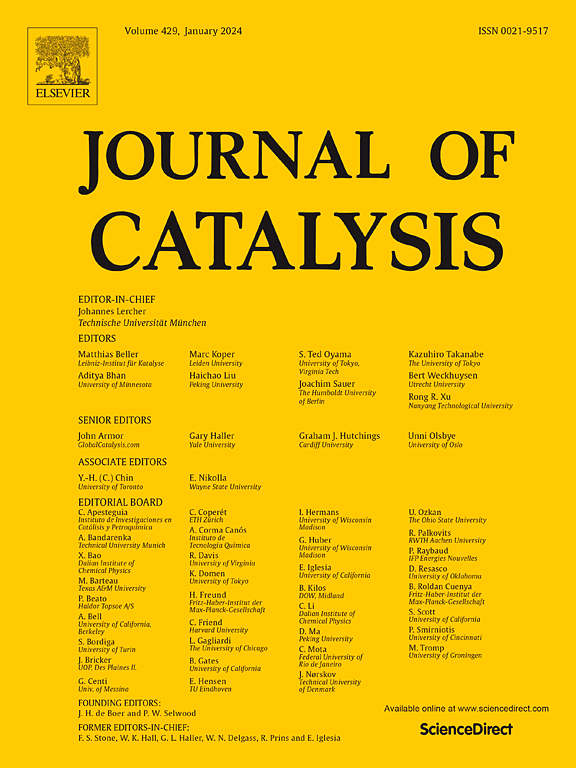Enhancing electron penetration through carbon shell of encapsulated catalysts by Co alloying for aromatic nitrobenzene hydrogenation
IF 6.5
1区 化学
Q2 CHEMISTRY, PHYSICAL
引用次数: 0
Abstract
Encapsulated catalysts have become a new strategy for catalysis in harsh reaction environments due to their unique structural and functional reorganization properties, and they have been widely applied in fields such as electrocatalysis, photocatalysis, and thermocatalysis. In strategies involving encapsulated catalysts, the optimization of electronic properties on the carbon layer surface to enhance reactivity while maintaining adequate encapsulation poses a challenge due to the trade-off between stability, poison resistance, and acid resistance against the performance of metal nanoparticles. Herein, an alloying strategy for Co-Ni bimetal was proposed, which achieves a delicate balance between catalyst activity and stability. Ni plays a pivotal role in promoting the formation of graphitized carbon and the construction of an effective encapsulation structure, thereby ensuring the stability of the catalyst. Co incorporation and alloying with Ni modulates the electronic state and D-band structure within the metallic core, effectively breaking the electronic cloud segregation barrier imposed by the carbon shell. This modulation notably enhances the efficiency of reactions. For the hydrogenation of p-CNB to p-CAN, Co2Ni8@C exhibits an extremely low apparent activation energy (53.40 KJ/mol), as well as > 99 % conversion and selectivity.


用钴合金化方法提高芳香族硝基苯加氢催化剂碳壳中电子的穿透性
封装催化剂以其独特的结构和功能重组特性,成为恶劣反应环境下催化的一种新策略,在电催化、光催化、热催化等领域得到了广泛的应用。在涉及封装催化剂的策略中,优化碳层表面的电子性质以提高反应性,同时保持足够的封装性,这是一个挑战,因为要权衡金属纳米颗粒的稳定性、耐毒性和耐酸性。本文提出了一种钴镍双金属的合金化策略,在催化剂活性和稳定性之间取得了微妙的平衡。Ni在促进石墨化碳的形成和构建有效的包封结构,从而保证催化剂的稳定性方面起着举足轻重的作用。Co的掺入和Ni的合金化调节了金属芯内的电子态和d带结构,有效地打破了碳壳施加的电子云隔离屏障。这种调制明显地提高了反应的效率。对于p-CNB加氢生成p-CAN, Co2Ni8@C表现出极低的表观活化能(53.40 KJ/mol),并且 >; 99% %的转化率和选择性。
本文章由计算机程序翻译,如有差异,请以英文原文为准。
求助全文
约1分钟内获得全文
求助全文
来源期刊

Journal of Catalysis
工程技术-工程:化工
CiteScore
12.30
自引率
5.50%
发文量
447
审稿时长
31 days
期刊介绍:
The Journal of Catalysis publishes scholarly articles on both heterogeneous and homogeneous catalysis, covering a wide range of chemical transformations. These include various types of catalysis, such as those mediated by photons, plasmons, and electrons. The focus of the studies is to understand the relationship between catalytic function and the underlying chemical properties of surfaces and metal complexes.
The articles in the journal offer innovative concepts and explore the synthesis and kinetics of inorganic solids and homogeneous complexes. Furthermore, they discuss spectroscopic techniques for characterizing catalysts, investigate the interaction of probes and reacting species with catalysts, and employ theoretical methods.
The research presented in the journal should have direct relevance to the field of catalytic processes, addressing either fundamental aspects or applications of catalysis.
 求助内容:
求助内容: 应助结果提醒方式:
应助结果提醒方式:


